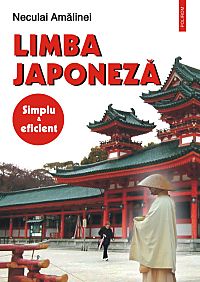 Japanese Language online course. Japanese Language online course.
For information please email us or complete the form in the contact page.
|
|
 |
| |
Introduction | Contents | Grammar
 Japanese language Japanese language
Simply and efficiently
Author: Neculai Amalinei
2nd Edition, Polirom Publishing House, Iasi, 2004.
192 pages, 160x235 mm
ISBN: 973-681-840-3
Price: 219000 lei / 21.90 lei noi
Available: Yes
:: Order online :: |
 |
"Japanese Language. Simply and Efficiently" is a linguistic approach to an ancient culture.
Basic grammar, vocabulary, pronunciation are featured in this book.
Nouns, adjectives, pronouns, verbs, grammar structures, greetings, etc., are useful both for the students who have an advanced level in Japanese studies and for those who wish to begin the fascinating journey of the Japanese language study.
This textbook consists of two chapters, each of them with a definite structure.
Chapter one has 25 lessons written in Japanese and Romanian.
Each lesson has a good and expressive lexical background and it is accompanied by exercises and specific pictures about Japan.
The last page of the lessons renders the text written in Japanese.
The second chapter defines the way of writing Japanese with hiragana, katagana and kanji.
At the end of the textbook there is a Japanese-Romanian dictionary with the words that belong to the lessons and a grammar appendix with the items presented.
The texts are agreeable and expressive and are written with both Latin and Japanese characters. Every sentence written in Japanese is accompanied by its corresponding translation into Romanian.
The main grammar problems featured are:
- nouns;
- relatives "kore", "sore", "are" and "dore";
- copula "desu";
- particles: "wa", "ga", "ni", "no", "e", "de", "to" etc.;
- negative and interrogative;
- adjectives;
- attributive and predicate use of the adjective;
- negative use of the adjective predicate;
- the interrogative pronouns "nani", "dare", "dore", etc.
- expressions of existence,
- answering "hai" and "iie",
- place and direction,
- expressing number and quantity,
- numbers and numerals,
- how to count things and persons,
- expression of possession,
- words for describing the family relations,
- the verb: predicate and speech style, conjunctive form, "masu" and "mashita" forms, conjugation of verbs,
- pointing time and minute,
- direct and indirect objects, etc.
The information regarding: kana syllabaries, methods of transliteration, general rules for reading, historical background and linguistic imports of kanji in Japan, illustrated kanji etc., are introduced in an interesting and accessible manner.
The author expresses his deepest gratitude to:
- Professor Rodica Cricler for the adequate Romanian grammar support provided;
- Professor James Breen, Monash University, Australia, for his continuos support in transposing the creative ideas regarding the language, history and civilization of Japan;
- Dr. Ken Lunde, Senior Computer Scientist, CJKV Type Development, Adobe Systems Incorporated, for the logistic related to the Japanese fonts;
- Japanese associated lectures for the study of Japanese Language and Civilization in Rumania, for their effort and devotion in expressing the Japanese cultural message;
- Mrs. Irina Apostoloiu for the understanding, talent and sensitivity in kanji illustrating.
- In order to introduce the reader into the Japanese environment there were used pictures of Katsushita Hokusai and Andö Hiroshige.
Neculai Amalinei |
|
|